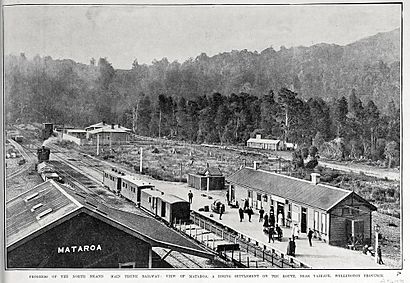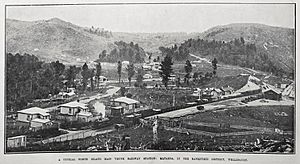Mataroa railway station facts for kids
Quick facts for kids
Mataroa railway station
|
|||||||||||
|---|---|---|---|---|---|---|---|---|---|---|---|

Mataroa in 1908
|
|||||||||||
| Location | New Zealand | ||||||||||
| Coordinates | 39°38′57″S 175°43′09″E / 39.649169°S 175.719253°E | ||||||||||
| Elevation | 530 m (1,740 ft) | ||||||||||
| Line(s) | North Island Main Trunk | ||||||||||
| Distance | Wellington 261.15 km (162.27 mi) | ||||||||||
| History | |||||||||||
| Opened | 11 September 1905 | ||||||||||
| Closed | Passenger 8 September 1975 Goods 22 September 1986 |
||||||||||
| Electrified | June 1988 | ||||||||||
| Services | |||||||||||
|
|||||||||||
Mataroa was once a busy train station in New Zealand. It was located in the Ruapehu District and served the small village of Mataroa. The station was an important stop on the North Island Main Trunk railway line.
It was about 9.3 kilometers (5.8 miles) north of Taihape. It was also 9.64 kilometers (6 miles) south of Ngaurukehu. Mataroa station was built on a long uphill slope. This slope went from Taihape towards Waiouru. Mataroa was 88 meters (289 feet) higher than Taihape. It was also 110 meters (361 feet) lower than Ngaurukehu.
Contents
The Station's Story
Building the railway line near Mataroa started around 1903. By March 1905, the station yard was being set up. In April 1906, Mataroa became the end of the railway line for a short time. A road made of pumice stretched north from there.
The Public Works Department (PWD) built the station. They handed it over to NZ Railways (NZR) on June 1, 1907. The local Member of Parliament, Arthur Remington, officially opened the line. After this, Mataroa had three mixed trains (carrying both passengers and goods) each day.
Before the official opening, passengers could ride on special ballast trains. They could also use passenger trains during the 1906-1907 Christmas holidays. Goods started being carried from September 11, 1905. Regular freight services began on May 18, 1906. The railway line to Waiouru was finished by July 1, 1908. This meant passengers no longer had to change trains at Mataroa.
Station Buildings and Features
In October 1905, a contract was made to build the station buildings. It cost £1600. However, in 1906, they decided the station needed to be bigger. So, in 1907, another contract was made for £827 to extend it.
Sadly, this station building burned down in 1928. A new one was built in 1929. Electric lights were added to the new station in 1930.
By July 1, 1907, the station had several important features. There was a passing loop where trains could wait for others to pass. This loop was long enough for 55 wagons. There was also a passenger platform with a way for carts to get close. A loading bank helped with moving goods. A large goods shed, 30 feet by 40 feet, was also built. There were also yards for cattle and sheep.
A station building, signals, and a house for the stationmaster were added by August 1, 1908. The passing loop was made even longer in 1957 to handle more trains.
Local Connections
From August 1906, a sawmill owned by Smith & Donald had its own tramway. This small railway line was 2 miles long and connected the sawmill to the main railway. Another sawmill also had a 1.5-mile tramway link.
Houses were built for railway workers too. A cottage was built in 1904. More cottages for platelayers (people who maintain the tracks) followed in 1907 and 1908. Two more state houses were added in 1954.
A telegraph line connected Mataroa to Taihape from December 1905. This line was later extended to Turangarere and Bennett's Siding in 1906.
A post office opened at the station on June 5, 1907. Railway staff ran it from July 16, 1908. The post office moved away from the station on February 14, 1969. Mataroa had a station master from August 22, 1906, until November 10, 1967.
How Many People Used the Station?
The number of passengers at Mataroa station was highest when people had to change trains there. After the line was fully open, passenger numbers dropped. They then stayed at about 20 passengers per day on average.
However, the station was very important for moving goods. A lot of cattle, sheep, wool, and timber were transported from Mataroa. In fact, among many stations between Hamilton and Marton, Mataroa was one of the most important for its goods traffic.
Tunnels Near Mataroa
The railway line near Mataroa follows the Hautapu River for much of its path. South of Mataroa, the railway goes through a long tunnel. This tunnel is 660 yards (604 meters) long. It was built to help the train line go more directly through the Namunui Stream valley.
Work on boring this tunnel started in 1903. The two ends of the tunnel met (called "breakthrough") in 1904 or 1905. The tunnel was fully finished in 1906. In 1984, the tunnel was prepared for the railway line to be electrified.
Another tunnel, called No. 12 or Hedgehog tunnel, was north of Taihape. This tunnel was 120 yards (110 meters) long and curved. In 1985, it was bypassed (a new path was built around it). This was done to make it easier to electrify the railway line. This change also made the distance between Taihape and Mataroa slightly shorter.
Bennett's Private Siding
H.D. Bennett owned a sawmill and asked for a special railway siding in November 1905. A siding is a short track connected to the main line. This siding was built in 1906, about 2 miles and 30 chains (about 3.8 kilometers) from Taihape. It was big enough for 38 wagons. This siding was used by four different sawmills in the area. The place where it was located is now known as Bennetts Siding.



